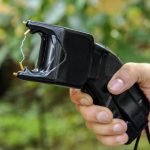When Can Police Use a Taser in New South Wales?

NSW’s State Crime Command’s Homicide Squad are investigating a case where a New South Wales man died after being tasered and pepper sprayed by police.
Two police officers responded to a callout to 27-year old James Peachy’s home in Gunnedah just after 8pm on Thursday, 20 May 2021.
Police allege that Mr Peachy began acting in a “hostile way” towards them. Officers used a taser and OC spray (capsicum spray) on Mr Peachy before he lost consciousness.
Officers say they performed CPR until paramedics arrived and took Mr Peachy to the local hospital, where he died a short time later.
A female officer was also treated at the hospital for a bite wound to her right forearm and an injured left knee.
While many questions remain unanswered, a young man is now dead, after receiving a visit from NSW Police.
His family, friends and community are demanding answers.
A critical incident team from New South Wales State Crime Command’s Homicide Squad have begun investigating the circumstances of the death.
Police say the investigation will also be subject to independent review.
Tasers and OC spray are not ‘soft’ options
Tasers were introduced to the NSW Police Force in 2002, and since then their use has come under a lot of scrutiny, because while tasers are an effective tool for managing violent situations, without police officers having to resort to using firearms and lethal force, it doesn’t mean that tasers aren’t dangerous. In fact they can be lethal.
It has been well-documented that a taser to the chest area can potentially cause cardiac arrest.
A 2016 study in America also found that a taser shock can produce serious short-term impairment in a person’s ability to remember and process information. The findings raise serious questions about the ability of tased people to understand their rights at the point of arrest.
Capsicum (OC) Spray is also gaining a reputation for being potentially deadly as recent research by The International Network of Civil Liberties Organizations (INCLO) and Physicians for Human Rights found that more potent formulations of pepper spray are increasingly the weapon of choice by police.
They also report that OC preparations may also include other toxic chemicals, such as alcohol, halogenated hydrocarbons, or propellants. Such combinations make it more difficult to treat exposures.
But other research from overseas has also cautioned about the other chemicals often used with OC, noting, “Inhalation of high doses of some of these chemicals can produce adverse cardiac, respiratory and neurologic effects, including arrhythmias and sudden death.”
There are strict guidelines for the use of both capsicum spray and tasers by police.
In NSW they can be used by general duty police officers and specialist officers related to the Riot Squad, or Tactical Operations Unit.
Police can only possess and use tasers for the purposes that’s considered in connection with their duty as a police officer.\
When Can Police Use a Taser in NSW?
Under section 231 of the Law Enforcement (Powers and Responsibilities) Act 2002, a police officer may use such force as is reasonably necessary to make the arrest or to prevent the escape of the person after arrest, when exercising the power of arrest.
According to NSW Police guidelines, tasers may be discharged at the discretion of officers, following an assessment of the situation and where it is ‘reasonably necessary’. It gives officers the direction that tasers may be used to:
- Protect human life,
- Protect yourself or others where violent confrontation or violent resistance is occurring or imminent,
- Protect an officer(s) in danger of being overpowered or to protect themselves or another person from the risk of actual bodily harm, or
- Protect from animals.
The possession of capsicum spray or a taser without a permit or authorisation is illegal under the law, and can attract a maximum penalty of 14 years in prison.







